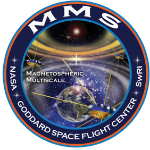We report on MMS high-latitude boundary layer observations on November 27 2021 when THEMIS and Cluster were located near the dusk-side low-latitude magnetopause and observed several periods of enhanced Kelvin-Helmholtz (KH) wave activity between 07 and 11 UT. MMS crossed the magnetopause in the southern hemisphere near the dusk-side terminator close to the local time of Cluster. IWF was predominantly southward at the beginning of the interval and was mainly northward after 07:00 UT. This interval coincides with the Earth-flyby of Solar Orbiter, which traversed the nightside magnetosphere and encountered the dusk side tail-flank boundary region. Between 8:15-9:15 UT encountered flow-shear boundaries between tailward flowing lobe-like plasma and Earthward moving cold dense plasma sheet-like region mixed with hot ions inside the high-latitude magnetosphere. The latter region contains density/temperature fluctuations comparable to KH-like wave disturbance observed at the magnetopause by Cluster during the same interval. We discuss the external and internal interaction processes that may explain these boundary disturbances. The unique constellation of fleet of spacecraft fleets, covering different magnetospheric boundaries simultaneously enable us to study the effect of the KH-like magnetopause disturbances on the dynamics of the dusk-side magnetosphere in an extended region.
|
|
|
|
High-latitude boundary layer disturbances associated with Kelvin-Helmholtz like waves in the dusk-side flank magnetopause
1 : Space Research Institute, Austrian Academy of Sciences
2 : ISAS/JAXA
3 : SwRI
4 : NASA/GSFC
5 : IWF,OEAW
6 : APL
7 : L
Polytechnique - X
8 : IRAP
CNRS, CNRS : UMR5277
9 : Beihang University
10 : ESTEC/ESA
11 : ESAC, ESA
12 : Imperial College
13 : MSSL
14 : NASA/GSFC
15 : UCB
16 : ASI
|

 PDF version
PDF version
